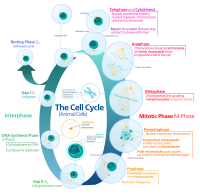
Photo from wikipedia
Chromatin - the functional form of DNA in the cell - exists in the form of a polymer immersed in a nucleoplasmic fluid inside the cell nucleus. Both chromatin and… Click to show full abstract
Chromatin - the functional form of DNA in the cell - exists in the form of a polymer immersed in a nucleoplasmic fluid inside the cell nucleus. Both chromatin and nucleoplasm are subject to active forces resulting from local biological processes. This activity leads to non-equilibrium phenomena, affecting chromatin organization and dynamics, yet the underlying physics is far from understood. Here, we expand upon a previously developed two-fluid model of chromatin and nucleoplasm by considering three types of activity in the form of force dipoles - two with both forces of the dipole acting on the same fluid (either polymer or nucleoplasm) and a third, with two forces pushing chromatin and solvent in opposite directions. We find that this latter type results in the most significant flows, dominating over most length scales of interest. Due to the friction between the fluids and their viscosity, we observe emergent screening length scales in the active flows of this system. We predict that the presence of different activity types and their relative strengths can be inferred from observing the power spectra of hydrodynamic fluctuations in the chromatin and the nucleoplasm.
Journal Title: Soft matter
Year Published: 2022
Link to full text (if available)
Share on Social Media: Sign Up to like & get
recommendations!